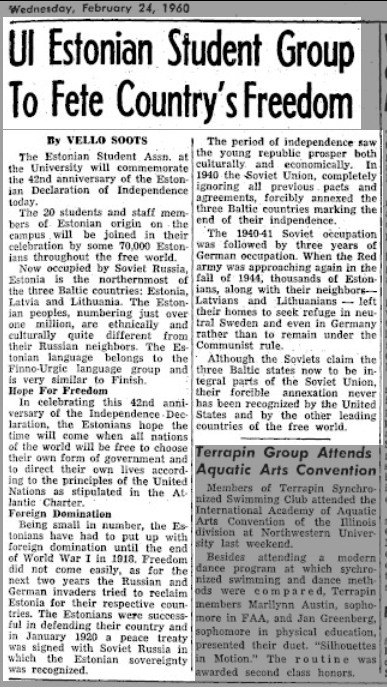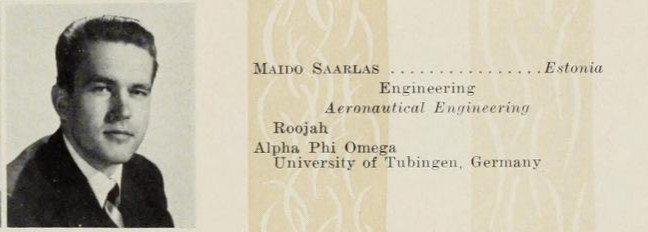Since at least 1950, Estonian students have been a part of the University of Illinois. Estonian Illini have included accountants, aeronautical and astronautical engineers, chemical engineers, electrical engineers, foreign language scholars, journalists, librarians, literary scholars, philanthropists, physicists, research scientists, and university faculty. Read on to learn more about early Estonian Illini!
- A Daily Illini article announcing an Estonian Student Association event on campus, found in Record Series 41/8/802.
Early Illinois – Estonia Connections
Before the first Estonian students came to campus, about thirty years after the February 24, 1918 declaration of independence in Estonia, some early twentieth century Estonian history is documented in the University Archives. For example, following World War One, the YMCA Secretary and YWCA Secretary (respectively) Donald A. Lowrie and Helen O. Lowrie visited and documented multiple European sites including Narva, Estonia, during their careers. After the war, there was a prisoner exchange program in Narva and the Donald A. Lowrie and Helen O. Lowrie Papers (Record Series 15/35/53) document these events through correspondence and photographs. Also, the Paul B. Anderson papers, (Record Series 15/35/54), include a photograph album which documents war prisoners aid work at Narva (1920-21) in pictures. Also, it should be noted that the University Library has a large Estonian language collection with reference materials too.
Early Estonian Illini
The first Estonian Illini may be displaced persons who came to Illinois after World War Two. Like some Latvian, Lithuanian, and Ukrainian Illini, some Estonian Illini were unable to return home after the war. Fortunately, communities and schools like the University of Illinois were able to arrange support for these students to continue their studies. Multiple Estonian Illini came to Chicago where they enrolled in a two-year transfer program at the former University of Illinois Navy Pier campus, before transferring to other Illinois schools to complete a bachelors program. [1]
Mr. Oleg Golubjatnikov, of Kuressaare, (B.S. Electrical Engineering, 1952) left few records behind from his student days but he left a great impression on Estonian American and Estonian history. His father, Dmitry Golubjatnikov, of Narva, was a medical doctor who trained in St. Petersburg, Russia. In 1941, Dmitry was sent to a Soviet gulag in Krasnoyarsk Krai and he died one year later [2]. Oleg, with his brother and his mother, left for Sweden but they temporarily settled in Geislingen, Germany, where both brothers attended high school in an Estonian refugee community. Later, they relocated to the United States, where Mr. Golubjatnikov completed a bachelors and a masters degree at the University of Illinois. After graduation, Mr. Golubjatnikov worked at General Electric where he developed computer systems and at the U.S. Department of Defense where he collaborated with other scientists to develop the Internet. [3] In 1990, his collaborations continued and he was a founder of the Estonian American Fund which supports the development of the Estonian nation. [4]
- A 1952 Illio profile photo of Oleg Golubjatnikov, found in Record Series 41/8/805.
Another fellow Estonian Illini and Geislingen alumni is Mr. Maido Saarlas, (B.S. Engineering, 1953, M.S. Hydrodynamics, 1954) of Tartu. After completing two degrees at the University of Illinois, Mr. Saarlas later completed a doctorate degree at the University of Cincinnati before joining the faculty at the United States Naval Academy in Annapolis, Maryland.
- A 1953 Illio profile photo of Maido Saarlas, found in Record Series 41/8/805.
A third Geislingen alumni is Mr. Lembit Lilleleht, (PhD, Chemical Engineering, 1962) who co-founded the first Estonian student organization on campus while he was a graduate student. After graduation, Dr. Lilleleht was an Assistant Professor at the University of Alberta-Edmonton, an Associate Professor at the University of Virginia at Charlottesville, and a visiting senior research scientists at the NASA Goddard Space Flight Center.
Four years later, a fourth Geislingen alumni, Mr. Ahto Palm-Leis, (PhD, Aeronautical and Astronautical Engineering, 1966), of Haapsalu, completed his doctoral program. [5] After graduation, Dr. Palm-Leis worked at the Arnold Engineering Development Center in Tennessee and the Ontario Ministry of Transportation in Toronto.
The 1960s saw the first two Estonian women on campus. Both women entered careers in librarianship and accountancy.
Annelie Gisela Rosenburg, (B.A. in LAS, German, 1963).
- A 1963 Illio profile photo of Annelie Rosenburg, found in Record Series 41/8/805.
Kristi Maria Salm, (B.S. Accountancy, 1963), of Tallinn.
- A 1963 Illio profile photo of Kristi Salm, found in Record Series 41/8/805.
Concurrent with the arrival of the first Estonian women students, Dr. Temira Pachmuss joined the faculty of Slavic Languages and Literatures. Dr. Pachmuss, (Professor of Slavic Languages and Literatures, 1961-1999), of Vask-Narva, was both a University professor, a scholar of Russian writers who left the Soviet Union in 1917, and a generous donor of personal papers and a great collection of Russian expatriate writers to the University Archives, (Record Series 15/20/21). Professor Pachmuss herself was born in Estonia, and she later lived in both Germany and Australia before continuing her education in the United States. Shortly after retirement, on March 30, 2001, Professor Pachmuss received the Medal of the Order of the White Star at the Estonian Embassy in Washington, D.C. [6]
Student Organizations
From 1958 until 1964, the Estonian Student Association organized to unite Estonian students on campus. [7] In 1958, the group was founded by a group of twenty students and many of those students continued their studies for advanced degrees too. The ESA organized cultural events on campus, including annual celebrations of the Estonian Independence Day on every February 24.
- The Estonian Student Association student organization application, found in Record Series 41/2/41, Box 9.
Though smaller in population size, Estonian students have been great in their achievements on campus and beyond, as accomplished scholars, effective organizers, and supportive peers of Estonians and other Illini everywhere.
Are you an Estonian Illini? Do you know someone who is? We’d like to hear from you! Please send us a message or leave a comment below. We want to include you and your story, as we celebrate the first 150 years of the University of Illinois.
Happy First 150 everyone!
(A special thank you to the 2015-2016 University of Illinois Slavic Graduate Student Association and Dr. David Cooper who gave feedback on an early version of this work.)
References
[1] Many Estonian Illini who attended UI-Navy Pier had also attended the Geislingen Estonian High School (Geislingeni Eesti Gümnaasium), in Geislingen, Germany. In this Southern German city, for years, thousands of Estonian refugees (from the Soviet occupational government in Estonia) lived until a new permanent home could be arranged. Please see (in German): Stille, Bernhard. Vom Baltikum ins Schwabenland: Estenlager und Ausquartiertenschicksal in Geislingen, 1945 – 1950. Taschenbuch. 1994.
[2] Helbe Merila-Lattik. Eesti arstid 1940–1960. Tallinn: Valge Raamat. 2011.
[3] “Oleg Golubjatnikov.” Nekroloog (Obituary), Postimees. Jaanuar 16, 2004.
[4] “History“, Estonian American Fund. Online. Accessed February 18, 2017.
[5] For an interview with Dr. Palm-Leis, please see (in Estonian): “Eestlane seisab teelahkmel.” Kultuur ja Elu. 2003. Number 1. Page 33.
[6] “Temira Pachmuss to Receive Medal of Honor from Republic of Estonia” by Andrea Lynn. Illinois New Bureau. March 27, 2001.
[7] “Estonian Student Association.” Student and Faculty Org. Constitutions & Registration Cards, 1909-2002. Record Series 41/2/41. Box 9.







